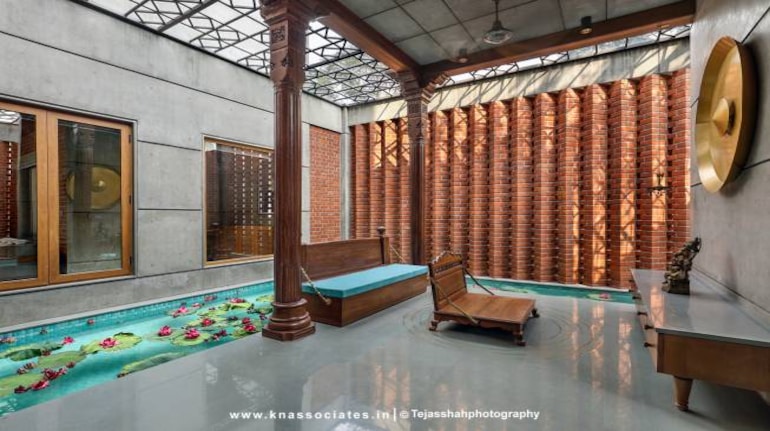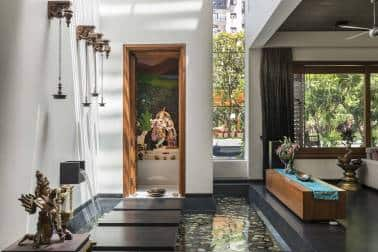



Sacred spaces are significant. That’s where you connect with something indefinable, beyond the cacophony and fuss of life. There's that quietude which allows you to breathe deeply, relax your shoulders and sink into the velvety blue darkness of peacefulness.
Navratra and Dussehra are times for reflecting on the divine and all that is great and good. The earth is cooling down after the harsh summer and monsoon months and the nine days are for prayers and togetherness with loved ones as Devi Durga visits humankind to be worshipped in all her divine manifestations as mother, nurturer of the universe and destroyer of evil.
Sacred spaces can be created anywhere — in your heart, mind or even a small corner in the house.
For some families, however, bigger is getting to be better.
Out of about a 100 clients, 80 per cent are now asking Vadodara-based architect Narendra Joshi, founder of KN Associates, to design puja rooms which are fairly large and well articulated. “Many people in Gujarat, including the Rajput and Marwari communities get their large families together for religious ceremonies and festivals, so it has to accommodate a number of people,” he says.
When Joshi was requested by infrastructure developer Rudradutt Rathod to design the three-level residential bungalow for his joint family, the brief was simple: That the puja room be vaastu-compliant like the rest of the house.
For Hardik Shah, founder of Surat-based Studio Lagom, the client’s request for a city-based project named Skewed House (a series of interconnected vistas add to the skewed look, says Shah) was interesting. “When the client was asked which deity should take pride of place, he said, ‘it has to be The One I look at from afar and feel happy’.” That happened to be Lord Krishna and for Shah “the entire theme came into perspective”.
The architect followed simple aesthetics and a minimal material palette when designing the 11,000 sq. ft villa, planned as an oasis of serenity in Surat’s “typical milieu”. However, instead of building a “forbidding” compound wall, he reversed the regular “streetside-scheme-and-garden-to-the-rear” format by setting the bungalow beyond an elevated garden.
 The puja ghar at the Skewed House, a part of - yet standing apart from - the earthly activities. Though part of an expansive living space, it gets its own identity as a soaring tower block standing within a kund.
The puja ghar at the Skewed House, a part of - yet standing apart from - the earthly activities. Though part of an expansive living space, it gets its own identity as a soaring tower block standing within a kund.The puja room had to have a distinct identity, so it was built close to the entrance as a double-height tower, heralded by a waterspout and set within a waterbody. “It’s a part of and yet stands apart on a platform, as if far away from earthly activities,” says Shah.
 The slit-like window visually connects the internal waterbody with the pond outside, heightening the symbolism of temples and temple tanks.
The slit-like window visually connects the internal waterbody with the pond outside, heightening the symbolism of temples and temple tanks.The deities, with Krishna and Radha being the focal point, stand before a triptych done in Mughal miniature style in vibrant colours. Plywood pieces were fitted on the wall to provide the back support for the canvas. Nature’s abundance, so dear to Krishna, was made a part of the picture.
“The L-shaped glass inset behind the puja tower invites the surrounding greenery in and connects the interior water body with the external lotus pond visually,” says Shah.
Joshi extended the exposed bricks and RCC design of the Rathod bungalow to the puja as the house had to “speak one language”. Articulated wooden columns sourced from an antique shop in Ahmedabad were put up to match the beautiful jharokha in another part of the house.
As most people are in the habit of saying a quick prayer while entering or exiting their homes, Joshi ensured the puja room was accessible from the entrance and visible from big windows. “We added a waterbody too, which is a vaastu feature,” he says.
The architects enjoy executing such projects with Shah drawing inspiration for his designs from India’s ancient temples. He says he makes it a point to “visit as many as I can, though one cannot cover all of them in a lifetime.” From the ruins of Hampi to the Golden Temple, he has studied the architecture, the building process, the art, the play of light in the structures, and “the hidden details that you can extract to create your own designs”. These are marvels of architecture created when no formal study of architecture existed, he says.
“There are so many things to understand about these ancient structures, the journey you make from the wide entrance of the temple to the small, intimate garbha griha or sanctum sanctorum, where you forget the outside world and come face-to-face with God.”
It’s like life — “just fascinating,” he concludes.
Discover the latest Business News, Sensex, and Nifty updates. Obtain Personal Finance insights, tax queries, and expert opinions on Moneycontrol or download the Moneycontrol App to stay updated!
Find the best of Al News in one place, specially curated for you every weekend.
Stay on top of the latest tech trends and biggest startup news.